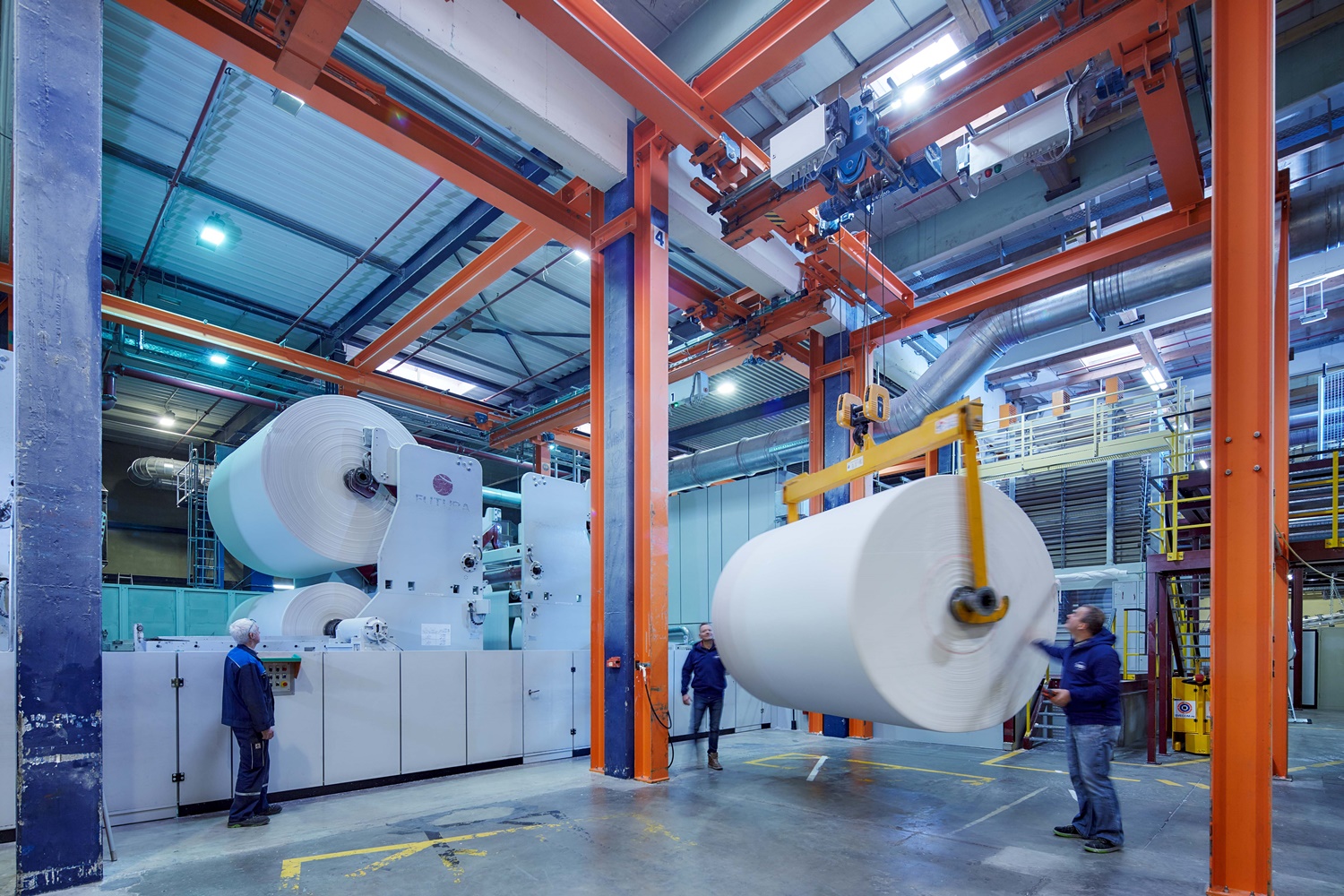P3 5-6/2022 en
Overall Equipment Effectiveness
Indicator for Successful Paper Production
Concepts & Solutions
How productive can shopfloors be? It is a fact that almost all production facilities are not operated optimally, and valuable resources are lost. Digital strategies, for example based on artificial intelligence (AI) and the Internet of Things (IoT), can be used to leverage unused potential in manufacturing. Both are key technologies and will be indispensable in our factories and machine parks in the future. Unlike sensors, cloud technology and 5G, which in the future will spread as a narrow but flexible network over the production facilities, the machinery itself will remain what it has always been: immobile and mostly unchanged. Whereby this does not mean it is “outdated”. In many factories, machines have been running smoothly for 30 years or more. The crucial question is how to get the most out of the existing equipment to make the best use of available resources.
Overall equipment effectiveness: Optimized machine control through real-time analysis.
What will the production line of the future look like and how can its effectiveness be measured and increased? Just like digital components, the various machines from different production lines, manufacturers, and years of manufacture must be closely coordinated. This is the best way to create a highly optimized manufacturing plant, which can become a complex unit through seamless communication between the machines and digital technologies. Coordinating all components with each other and thus exploiting the developed possibilities is one of the great challenges of any modern production. In short, there is a lot of potential for optimization. An important, if not the most important indicator here is the overall equipment effectiveness (OEE) as it describes the uptime of the equipment in relation to the overall production time. Thereby it puts the degree of utilization, performance and quality into an easily ascertainable relationship.
Today, OEE is a key concept for Industry 4.0. It is an important figure that serves as the basis for continuous improvement and adjustment of production. In the past, determining overall equipment effectiveness was a highly time-consuming and error-prone manual process, but thanks to digitalisation, OEE can be determined automatically and more precisely. This makes it easier to trace and address the causes of production losses. More and more machines are being equipped with ever more sensors, which gives a better picture of the process flow. At the same time, by collecting and evaluating large amounts of data, many correlations can be developed that help to make production more effective and optimize the coordination between the individual machines. Whether it is the coordination of different speeds between the machines of a production line or the reduction of unplanned downtimes - the key metric for benchmarking is the overall equipment effectiveness, which must be increased.
Optimized machine control through real-time analysis
This was also the goal of Körber's Business Area Digital when it founded FactoryPal. Initially, FactoryPal focused on the tissue industry, as the Körber technology group itself has its own business area with a special focus on the field of hygiene paper. This enabled the company to draw on detailed industry-specific knowledge of machine control and production machinery. In the meantime, FactoryPal is industry-agnostic and serves manufacturing companies in the process industry and has successfully positioned itself as an AI-driven, machine-agnostic SaaS solution. The FactoryPal solution processes production data and recommends optimal machine settings to machine operators in real-time via a mobile app. The data are collected at up to 600 data points per second through IoT gateways installed at the customer's site and are then transferred to the cloud for processing.
The solution has already been successfully implemented many times in different industries, including in a use case with a leading manufacturer of hygiene papers and recycled fibres. The data collected showed how much even small, unplanned downtimes in production can lead to significant OEE declines. For factories, it is a challenge to record and analyze the reasons for downtimes in detail to then react to them quickly and with the appropriate measures to minimize possible effects. This can only succeed if proactive action is enabled, and the influencing factors are recognized and addressed before a failure occurs. FactoryPal applies various ML (machine learning) models for this purpose. With the help of these models a data-driven digital image of the production line in the cloud - a Digital Twin - is created. This makes it possible to predict OEE and to optimize parameters, which yield a higher OEE. The FactoryPal solution reacts proactively to the conditions in production, in contrast to other solutions which are more focused on reaction and are less based on real-time data. This is a significant advantage made possible using large amounts of data.
Effectively predicting and improving OEE requires close cooperation with customers. The initial situation on the factory floors is often complex, which means a high number of parameters have to be processed and analyzed. In the mentioned use case, for example, the data from 30 production lines in nine European tissue factories was in scope to increase OEE through the interaction of humans, machines, and software. In such a project, errors and inconsistencies can reduce confidence in the information collected. To prevent possible errors right from the start, FactoryPal’s team of digital specialists built the entire value chain itself, including the artificial intelligence (AI) technology. Even the best ML model is doomed to fail if it is not applied correctly. Therefore, co-creation was deliberately chosen to address customer's needs from the beginning.
Machine data enables a look into the future
If you want to increase overall equipment effectiveness using software, AI and the human factor, you need much more than just machine data. What is described as "close cooperation with customers" means integrating very diverse IT systems and the exchange of data via their interfaces. To enable machine operators to look ahead and anticipate possible failures, the software combines data from different sources: machine data read from the PLCs (programmable logic controllers) on the shop floor, data from other customer systems such as ERP and MES (e.g., product specifications and work orders), and input from the machine operators (e.g., reason for rejecting a machine parameter recommendation).
After machine data are connected and transferred, they are evaluated in the cloud by the custom trained AI pipeline. Algorithms then calculate suggestions for optimization and send them to the responsible machine operator. Since the application runs on a PC, smartphone or tablet, the device only plays a minor role in sending the optimization instructions. In the factories of the mentioned tissue paper manufacturer, significant OEE increases were achieved using AI-generated recommendations from FactoryPal. In addition, machine downtimes were significantly reduced. This example shows that measuring and improving OEE can make a significant contribution to optimizing production and increasing productivity of a plant. This is possible by analyzing machine failures in a targeted manner and deriving appropriate proactive measures.
It is crucial to deal with OEE as a decisive indicator for shop floor management. It is not enough connecting all machines on the shop floor to digitally orchestrate the multiplex machinery. The key is the analysis of machine data to enable better communication between the individual machines. This is the basis for powerful predictive tools supporting the machine operators. The result is a harmonised machine ensemble with significantly increased overall equipment effectiveness.








